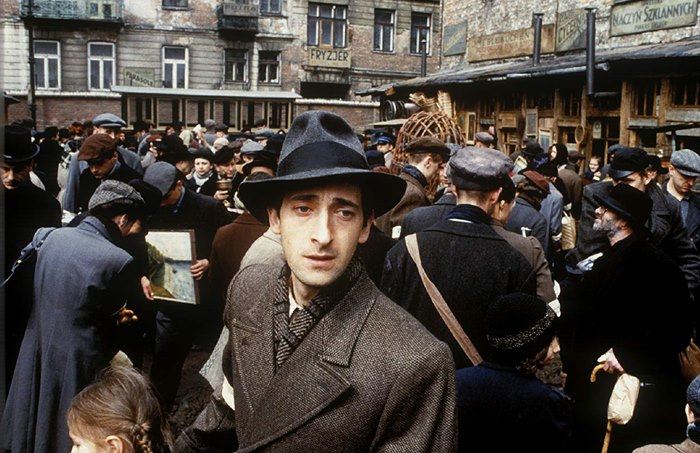The Pianist (2002)
- movie news
- August 22, 2024

Roman Polanski’s film “The Pianist,” released in 2002, is a poignant and harrowing account of survival during one of the darkest periods in human history. Based on the autobiography of Polish-Jewish pianist and composer Władysław Szpilman, the film offers a deeply personal and profound portrayal of the Holocaust and the resilience of the human spirit. With a gripping narrative, exceptional performances, and Polanski’s masterful direction, “The Pianist” stands out as a powerful testament to the horrors of war and the endurance of hope amidst despair.
“The Pianist” chronicles the life of Władysław Szpilman (played by Adrien Brody), a talented pianist living in Warsaw, Poland, as the Nazi invasion unfolds. The film begins in 1939, showcasing Szpilman’s successful career and his deep love for music. However, as the war progresses, Szpilman’s life is upended by the brutal realities of occupation. The Jewish community faces increasing persecution, and Szpilman and his family are forced into the Warsaw Ghetto.
As the war continues, Szpilman experiences profound loss and hardship. His family is deported to a concentration camp, and he is left to navigate the harrowing conditions of the ghetto and later the ruins of Warsaw as he hides from the Nazis. The film’s narrative follows Szpilman’s struggle for survival, his reliance on the kindness of strangers, and his enduring passion for music as a source of solace and strength.
Roman Polanski’s direction in “The Pianist” is both masterful and deeply personal. Having himself survived the Holocaust as a child, Polanski brings an intimate and authentic perspective to the film. His direction is characterized by its stark realism and emotional depth, capturing the horror of war and the resilience of those who endure it.
Polanski’s use of long, unbroken takes and detailed set designs enhances the film’s immersive quality. The director’s meticulous attention to historical accuracy and the emotional weight of Szpilman’s experiences contribute to a powerful and affecting portrayal of the Holocaust. The film’s pacing, combined with Polanski’s careful focus on character and setting, creates a haunting and memorable cinematic experience.

Adrien Brody’s portrayal of Władysław Szpilman is a standout element of the film. Brody’s performance is marked by its depth and nuance, capturing Szpilman’s transformation from a celebrated musician to a man struggling for survival. His ability to convey a wide range of emotions—from the initial joy and success of Szpilman’s career to the profound despair and fear of his later years—adds a layer of authenticity and emotional resonance to the character.
Brody’s physical transformation for the role, including his dramatic weight loss to reflect Szpilman’s starvation and suffering, is a testament to his commitment to the role. His portrayal of Szpilman’s inner turmoil, coupled with his skillful playing of the piano, makes his performance both compelling and heartbreaking. Brody’s work earned him widespread acclaim, including the Academy Award for Best Actor.

The supporting cast of “The Pianist” also delivers impressive performances, contributing to the film’s emotional depth and historical accuracy. Key figures include Thomas Kretschmann as Captain Wilm Hosenfeld, a Nazi officer who helps Szpilman during his time in hiding. Kretschmann’s portrayal of Hosenfeld is complex, capturing the character’s internal conflict and humanity amidst the brutality of the regime.
Other notable performances include Emilia Fox as a kind-hearted woman who aids Szpilman and Frank Finlay as an older Jewish man who provides crucial support. Each supporting actor adds depth to the film’s depiction of the varied experiences and relationships that shape Szpilman’s journey.

“The Pianist” is noted for its commitment to historical accuracy and its realistic depiction of wartime Poland. The film’s attention to detail extends to its set designs, costumes, and historical context, creating an authentic portrayal of life during the Holocaust. The devastated landscapes of Warsaw, the oppressive atmosphere of the ghetto, and the stark conditions of Szpilman’s hiding places are rendered with striking realism.
The film’s cinematography, by Janusz Kamiński, is both beautiful and harrowing. Kamiński’s use of light and shadow, combined with his framing of key scenes, enhances the emotional impact of the narrative. The cinematography complements Polanski’s direction, creating a visually stunning and emotionally powerful representation of Szpilman’s story.

At its core, “The Pianist” explores themes of survival, resilience, and the power of art. Szpilman’s story is a testament to the human spirit’s capacity to endure and find hope in the face of unimaginable suffering. The film’s focus on Szpilman’s love for music underscores the role of art as a means of escape and expression, even in the darkest of times.
The film also addresses the impact of war on individuals and communities, highlighting the personal and collective losses experienced during the Holocaust. By presenting Szpilman’s story through a deeply personal lens, “The Pianist” offers a poignant reflection on the effects of war and the enduring strength of the human spirit.
“The Pianist” is a powerful and haunting film that stands as a testament to Roman Polanski’s directorial skill and Adrien Brody’s exceptional performance. Through its detailed portrayal of Władysław Szpilman’s life during the Holocaust, the film offers a profound exploration of survival, resilience, and the impact of war.
With its commitment to historical accuracy, emotional depth, and striking cinematography, “The Pianist” remains an important and impactful film. It serves as a moving reminder of the atrocities of the Holocaust and the strength of those who endured them, making it a significant addition to the genre of historical drama.











